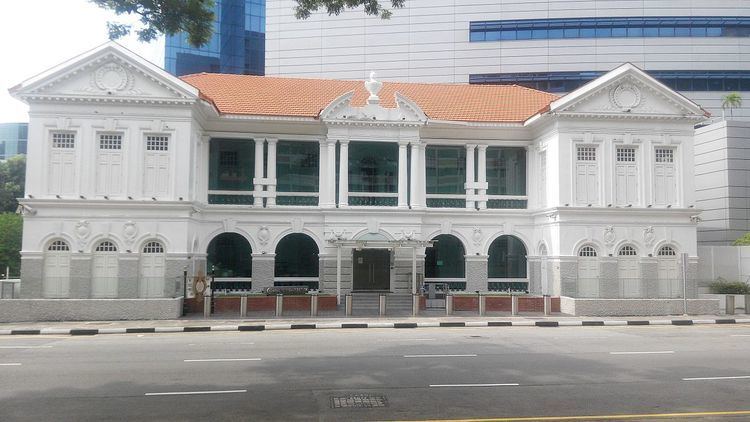Motto Pure and Honest Established 4 August 1888 School code 5020; 7309 Founded 4 August 1888 | Religious affiliation(s) Methodist Session Single (Day) Phone +65 6778 8431 | |
 | ||
Type Government-Aided (Both); Autonomous (Sec only) Similar Fairfield Methodist Secondary, Henry Park Primary School, Nanyang Primary School, Methodist Girls' School, New Town Primary School | ||
Fairfield Methodist School (Primary) (abbreviation: FMS(P)) and Fairfield Methodist School (Secondary) (abbreviation: FMS(S)) are two schools located on Dover Road. Founded in 1888 as the Anglo-Chinese Girls School, they are among the oldest primary and secondary schools in Singapore. Their current premises are at the neighbourhood of Dover in Queenstown, Central Singapore.
Contents
The Beginning
Miss Sophia Blackmore, a 31-year-old Australian missionary from the Methodist Women's Foreign Missionary Society, had just established her first school in Singapore. Meanwhile, several influential Chinese families were persuading her to teach their daughters. A widow later offered Blackmore her home along Cross Street for teaching.
On August 1888, the Anglo-Chinese Girls' School began with just eight Peranakan girls.
Contradicting accounts
However, there have been conflicting and differing stories on how the school really started, especially from the history book, Singapore: A Biography.
According to the sources, Fairfield was started in August 1888 by Miss Sophia Blackmore, a 31 year old missionary from the Methodist Mission. Her mandate in 1888 was to start a girls' school in Singapore in an enclave called Telok Ayer. She finally managed to start a class for eight Nonya girls in a little room at Cross Street. During that time, education for girls was definitely not favoured by the early traditional Chinese immigrants, even among the liberal-thinking Baba merchants. Miss Blackmore then started going house to house, trying to persuade families to enroll their girls in her school. However, little by little, they suspected that she was a government spy sent to catch them secretly gambling at cards. They had started to pass the word that the young missionary lady was in fact a 'mata-mata' agent who was helping the British government enforce its new law against gambling.
Miss Blackmore's habit of asking for the women's names and writing them down in her notebook seemed to have alarmed the women. This was actually done as a record of who she visited, but still, the parents were suspicious of her. In spite of the differences and even suspicion from parents, Miss Blackmore persevered in her vision for a girls' school, and found that the parents were starting to welcome her more cordially, and would even invite her to sit down and chat over a cup of tea. They started to become more receptive to the idea that it would be good for their daughters to get a little education.
In June 1888, Miss Blackmore finally managed to get her first pupil. She recalls,
How pleased we were when one little girl, hearing of the school, clapped her hands and begged her mother to let her attend. She had been nicknamed 'Gondol', which means bald, because her head had been shaved during sickness. Not much knowledge entered that little bald head, but her own willingness to come to school helped others to decide.
After Gondol's mother agreed to send her daughter to school, a few other mothers followed her lead. Altogether, seven more pupils were signed on. Soon, she managed to rent out the front room of Nonya Boon, a rich widow's front room. The Anglo-Chinese Girls' School was finally founded.
Early Years
The school was soon renamed Telok Ayer Girl's School. It is a common misconception that it was the original name the school was founded as. However, it is currently unknown when the name change took place.
In 1893, the new principal, Emma Ferris, found that the furniture had been removed because the landlady had decided to rent the room out to someone else to be used as a shop. She managed to find a new site for the school in a corner house along Telok Ayer Road. By then, the school had 30 students. In 1905, the school moved from the corner house at Telok Ayer into a larger house at Neil Road.
The principal, Miss Olson, realised that she required more space in the building and tried to raise funds for a new building. The biggest donation (USD 5,000) came from a Mr Fairfield from New England. This allowed the school to construct a new school building on a site provided by the government at Neil Road. The school moved from Telok Ayer into the new premises on Neil Road in 1912, and was promoted to a 'first-rate school' by the British Government. The relocated school was renamed Fairfield Girls' School. By 1917, the growth of the school had forced a hundred Fairfield girls to study in a dark shophouse. In response to this, a new block extension was completed, consisting of six classrooms and a chapel hall in 1924.
During the Japanese occupation of Singapore, the school was shut down. It only reopened in 1945. Between 1942 to 1944, the school building was taken over by the Japan Military Force.
In 1958 the school was renamed to Fairfield Methodist Girl's School.
On to Dover
In 1983, the school moved to its current Dover campus to accommodate a larger population of students. Concurrently, the school went co-educational, becoming the first Methodist School in Singapore to do so, and became two separate schools, Fairfield Methodist Primary School and Fairfield Methodist Secondary School, each with its own administration, but still under the Fairfield Methodist School Board of Management. The schools also saw its first intake of boys as well.
Fairfield (Primary)
To highlight the common history, heritage and close relationship of the Fairfield Methodist Schools, the name of the school was changed from Fairfield Methodist Primary School to Fairfield Methodist School (Primary), effective from January 2009.
